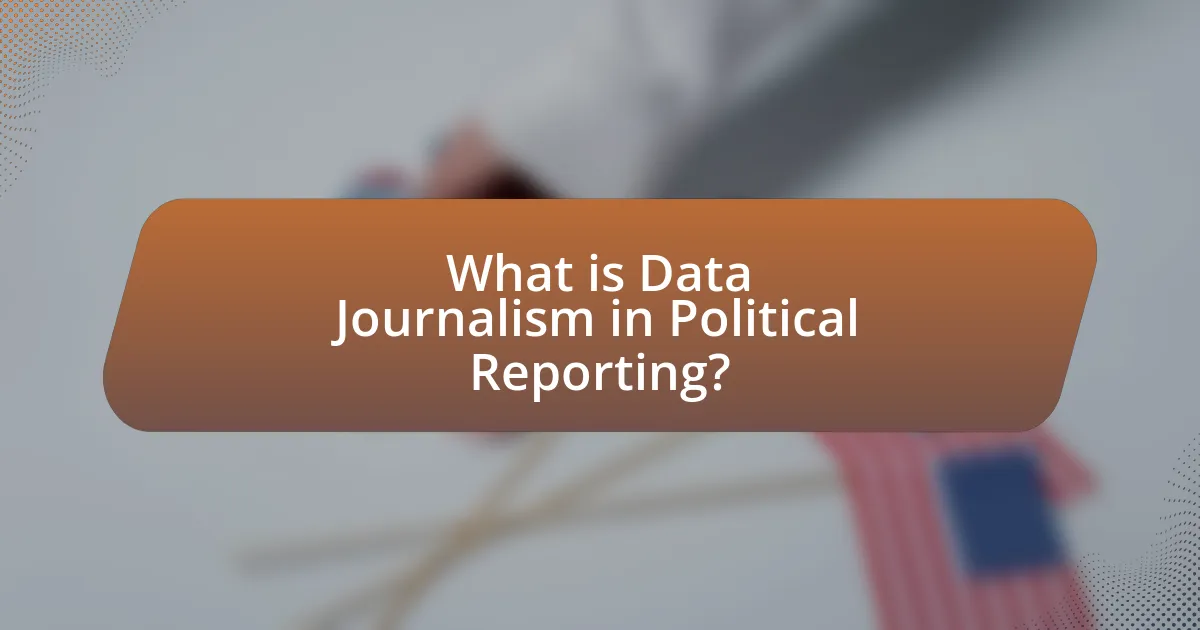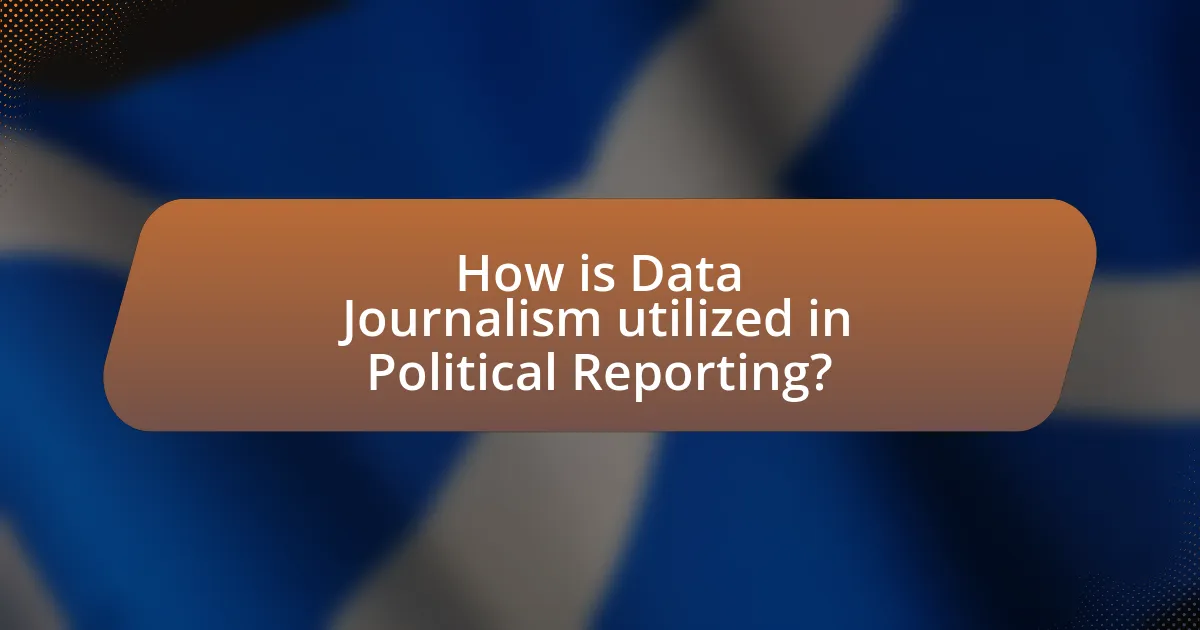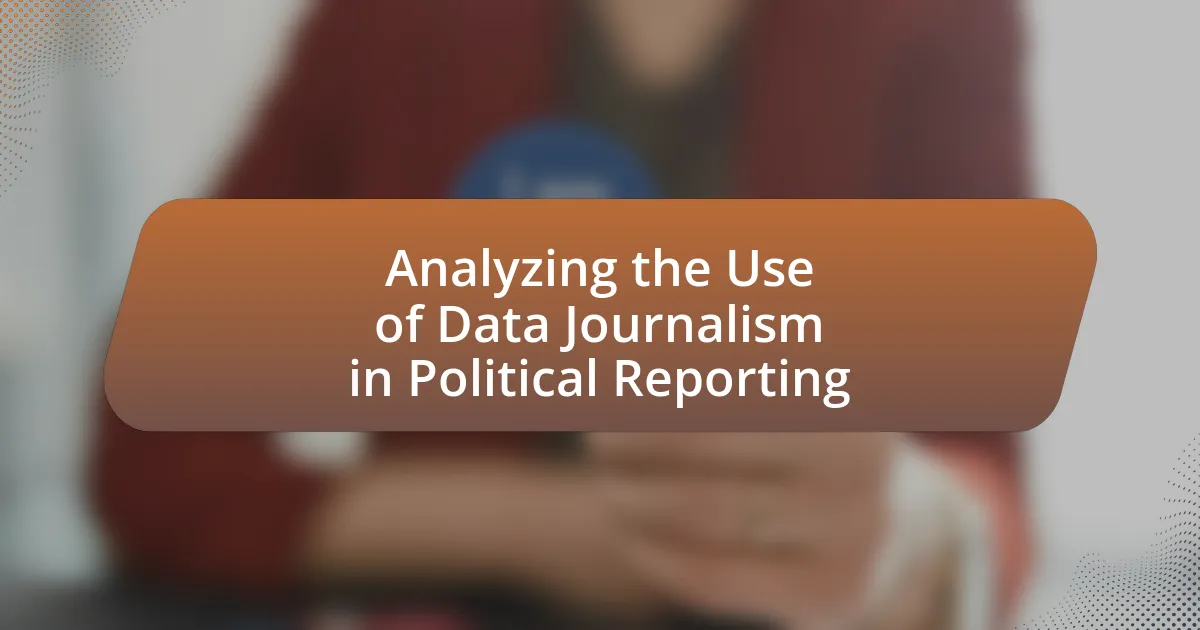Data journalism in political reporting is the integration of data analysis and visualization techniques to enhance the understanding of political issues and events. This article explores the distinctions between data journalism and traditional journalism, highlighting the importance of empirical evidence in reporting. Key characteristics of data journalism, such as the use of quantitative data and effective visualization, are discussed, along with its role in promoting transparency and accountability in governance. The article also addresses the challenges faced by data journalists, including data accessibility and bias, while emphasizing the ethical considerations and future trends shaping this evolving field.

What is Data Journalism in Political Reporting?
Data journalism in political reporting is the practice of using data analysis and visualization to uncover, explain, and report on political issues and events. This approach enhances traditional journalism by providing empirical evidence that supports claims, reveals trends, and offers insights into complex political phenomena. For instance, during elections, data journalism can analyze voter demographics and turnout statistics to inform the public about electoral dynamics, as seen in the 2020 U.S. presidential election where data-driven analyses helped predict outcomes in key battleground states.
How does Data Journalism differ from traditional journalism?
Data journalism differs from traditional journalism primarily in its reliance on data analysis to uncover stories and provide insights. While traditional journalism often focuses on narrative storytelling and qualitative reporting, data journalism emphasizes quantitative data, using statistical methods and data visualization to present information. For instance, data journalists may analyze large datasets to identify trends or patterns that inform political reporting, whereas traditional journalists might rely more on interviews and personal accounts. This approach allows data journalism to offer a more objective perspective, supported by empirical evidence, which can enhance the credibility of the reporting.
What are the key characteristics of Data Journalism?
Data journalism is characterized by its reliance on data analysis to tell stories and uncover insights. This form of journalism emphasizes the use of quantitative data, often sourced from public records, surveys, and databases, to support narratives and provide evidence for claims. Key characteristics include the ability to visualize data effectively, which enhances comprehension and engagement, and the application of statistical methods to interpret data accurately. Furthermore, data journalism often involves collaboration between journalists and data scientists, ensuring that complex data is translated into accessible formats for broader audiences. This approach has been validated by numerous studies, such as the Pew Research Center’s findings, which highlight the growing importance of data-driven reporting in enhancing transparency and accountability in political reporting.
Why is Data Journalism important in the context of political reporting?
Data journalism is important in the context of political reporting because it enhances transparency and accountability in governance. By utilizing data, journalists can uncover patterns, trends, and anomalies in political behavior, such as voting records, campaign financing, and public policy impacts. For instance, a study by the Pew Research Center found that data-driven reporting significantly increases public engagement and understanding of complex political issues, allowing citizens to make informed decisions. This reliance on empirical evidence helps to combat misinformation and provides a factual basis for political discourse, ultimately fostering a more informed electorate.
What role does Data Journalism play in enhancing political transparency?
Data journalism plays a crucial role in enhancing political transparency by providing data-driven insights that reveal government actions and policies. By analyzing large datasets, data journalists can uncover patterns, discrepancies, and trends that may not be visible through traditional reporting methods. For instance, investigations into campaign finance data have exposed the influence of money in politics, leading to greater public awareness and accountability. Furthermore, data visualizations can simplify complex information, making it accessible to a broader audience, thereby fostering informed public discourse. This approach not only holds political entities accountable but also empowers citizens with the knowledge needed to engage in democratic processes effectively.
How can Data Journalism uncover political corruption?
Data journalism can uncover political corruption by analyzing large datasets to identify patterns and anomalies that suggest unethical behavior. For instance, investigative reports often utilize public records, financial disclosures, and voting data to reveal discrepancies, such as unusual campaign contributions or conflicts of interest. A notable example is the Panama Papers investigation, where journalists analyzed leaked documents to expose global political figures involved in offshore tax evasion, demonstrating how data analysis can lead to significant revelations about corruption.
What examples illustrate the impact of Data Journalism on public accountability?
Data journalism significantly enhances public accountability through various impactful examples. One notable instance is the Panama Papers investigation, where journalists analyzed 11.5 million documents to expose global tax evasion by politicians and public figures, leading to resignations and policy changes in multiple countries. Another example is the reporting on police misconduct in the United States, where data analysis revealed patterns of racial profiling and excessive force, prompting public outcry and reforms in law enforcement practices. Additionally, the use of data in tracking government spending, such as the U.S. government’s Recovery Act, allowed journalists to hold officials accountable for the allocation of billions in stimulus funds, ensuring transparency and responsible use of taxpayer money. These examples demonstrate how data journalism serves as a powerful tool for fostering accountability in public institutions.

How is Data Journalism utilized in Political Reporting?
Data journalism is utilized in political reporting by analyzing and presenting data to uncover trends, inform the public, and hold political figures accountable. Journalists employ statistical analysis, data visualization, and interactive graphics to illustrate complex political issues, such as election results, campaign financing, and public opinion polls. For instance, during the 2020 U.S. presidential election, outlets like The New York Times and FiveThirtyEight used data journalism to provide real-time updates and forecasts based on voter demographics and historical voting patterns, enhancing public understanding of the electoral process. This approach not only aids in transparency but also empowers citizens to make informed decisions based on factual evidence.
What types of data are commonly used in political reporting?
Political reporting commonly utilizes quantitative data, qualitative data, and demographic data. Quantitative data includes statistics from polls, election results, and economic indicators, which provide measurable insights into public opinion and political trends. Qualitative data encompasses interviews, focus groups, and expert analyses that offer context and depth to political narratives. Demographic data, such as age, race, and income levels, helps reporters understand voting behaviors and societal impacts on political issues. These data types are essential for creating informed, accurate, and engaging political stories.
How do journalists source and verify political data?
Journalists source and verify political data through a combination of primary and secondary research methods, including interviews, official documents, and reputable databases. They often consult government reports, academic studies, and data from established organizations like the Pew Research Center or the World Bank to ensure accuracy. Verification involves cross-referencing information from multiple sources, fact-checking claims against reliable databases, and utilizing tools like data visualization software to analyze trends and patterns. For instance, the use of the Associated Press Stylebook guidelines helps maintain consistency and credibility in reporting.
What tools and technologies are essential for Data Journalism?
Essential tools and technologies for Data Journalism include data visualization software, statistical analysis tools, and programming languages. Data visualization software like Tableau and Google Data Studio enables journalists to create interactive and engaging visual representations of data, enhancing storytelling. Statistical analysis tools such as R and Python’s Pandas library allow for in-depth data manipulation and analysis, which is crucial for uncovering insights. Additionally, programming languages like SQL are vital for querying databases and extracting relevant information. These tools collectively empower journalists to analyze complex datasets and present findings in a clear, impactful manner, thereby improving the quality of political reporting.
How do journalists analyze data for political stories?
Journalists analyze data for political stories by employing statistical methods, data visualization techniques, and contextual research to interpret and present information accurately. They often begin by identifying relevant datasets, such as election results, public opinion polls, or government spending records, and then use software tools like Excel or specialized data analysis programs to clean and analyze the data. For instance, a study by the Pew Research Center found that 62% of journalists use data to support their reporting, highlighting the importance of data in enhancing credibility and depth in political narratives. By visualizing data through charts and graphs, journalists can effectively communicate complex information to their audience, making it easier to understand trends and implications in political contexts.
What statistical methods are frequently employed in political data analysis?
Statistical methods frequently employed in political data analysis include regression analysis, hypothesis testing, and descriptive statistics. Regression analysis, particularly logistic regression, is used to model the relationship between variables, such as voter behavior and demographic factors. Hypothesis testing allows researchers to determine the significance of their findings, often using p-values to assess the likelihood that results are due to chance. Descriptive statistics summarize data sets, providing insights into trends and patterns, such as voter turnout rates or election results. These methods are essential for drawing meaningful conclusions from political data, enabling analysts to make informed predictions and recommendations.
How can visualization enhance the understanding of political data?
Visualization enhances the understanding of political data by transforming complex datasets into accessible graphical representations, allowing for quicker comprehension of trends and patterns. For instance, a study by the Pew Research Center found that visualizations, such as charts and maps, significantly improve the ability of individuals to interpret electoral outcomes and demographic shifts. This is because visual formats can highlight relationships and anomalies that may not be immediately apparent in raw data, thus facilitating informed decision-making and public discourse.

What challenges does Data Journalism face in Political Reporting?
Data journalism faces several challenges in political reporting, primarily including data accessibility, data interpretation, and bias in data presentation. Data accessibility is a significant hurdle, as journalists often struggle to obtain reliable and comprehensive datasets from government sources or private entities, which can hinder thorough analysis. For instance, a study by the Tow Center for Digital Journalism highlights that many public datasets are incomplete or poorly maintained, making it difficult for journalists to draw accurate conclusions.
Additionally, data interpretation poses a challenge, as journalists must possess the necessary skills to analyze complex datasets and extract meaningful insights. Misinterpretation can lead to misleading narratives, which can significantly impact public perception and political discourse. Furthermore, bias in data presentation can occur when journalists selectively highlight certain data points while ignoring others, potentially skewing the audience’s understanding of political issues. This challenge is underscored by research from the Knight Foundation, which indicates that biased reporting can exacerbate polarization in political contexts.
What ethical considerations arise in Data Journalism?
Ethical considerations in data journalism include accuracy, transparency, privacy, and the potential for bias. Accuracy is crucial as journalists must ensure that the data presented is correct and not misleading; for instance, misrepresenting statistics can lead to false narratives. Transparency involves clearly communicating the sources of data and the methods used for analysis, which fosters trust with the audience. Privacy concerns arise when personal data is involved, necessitating adherence to regulations like GDPR to protect individuals’ information. Additionally, bias can occur in data selection and interpretation, which can skew public perception; therefore, journalists must strive for objectivity and represent diverse perspectives.
How do biases in data affect political reporting?
Biases in data significantly affect political reporting by skewing the representation of facts and influencing public perception. When data is collected, analyzed, or presented with inherent biases—such as selection bias, confirmation bias, or reporting bias—the resulting narratives can mislead audiences. For instance, a study by the Pew Research Center found that biased data can lead to misinterpretations of voter demographics, which in turn shapes political strategies and media coverage. This distortion can result in the amplification of certain viewpoints while marginalizing others, ultimately affecting democratic discourse and decision-making.
What are the risks of misinformation in Data Journalism?
The risks of misinformation in data journalism include the potential to mislead the public, distort facts, and undermine trust in media. When journalists present inaccurate data or misinterpret statistics, it can lead to false narratives that influence public opinion and policy decisions. For instance, a study by the Pew Research Center found that 64% of Americans believe that misinformation has caused confusion about basic facts, highlighting the significant impact of erroneous data reporting. Additionally, misinformation can erode the credibility of reputable news organizations, making it harder for audiences to discern reliable information from falsehoods.
How can journalists overcome challenges in Data Journalism?
Journalists can overcome challenges in Data Journalism by enhancing their data literacy and utilizing collaborative tools. Improved data literacy enables journalists to effectively interpret and analyze complex datasets, which is essential for accurate reporting. For instance, training programs and workshops focused on data analysis techniques can significantly boost journalists’ skills. Additionally, leveraging collaborative tools like Google Sheets or data visualization software allows teams to work together efficiently, ensuring that data is presented clearly and accurately. Research indicates that journalists who engage in continuous learning and collaboration produce higher-quality data-driven stories, thereby increasing the credibility and impact of their reporting in political contexts.
What best practices should journalists follow when reporting with data?
Journalists should ensure accuracy, clarity, and context when reporting with data. Accuracy involves verifying data sources and ensuring that statistics are correctly interpreted; for instance, a study by the Pew Research Center found that 62% of Americans believe that news organizations should prioritize accuracy over speed. Clarity requires presenting data in a way that is understandable to the audience, often through visual aids like charts or graphs. Context is crucial, as it helps the audience understand the significance of the data; for example, explaining the implications of a 10% increase in unemployment rates rather than just stating the figure. By adhering to these best practices, journalists can enhance the credibility and impact of their data-driven stories.
How can collaboration improve the quality of Data Journalism?
Collaboration can significantly improve the quality of Data Journalism by pooling diverse expertise and resources, leading to more accurate and comprehensive reporting. When journalists collaborate with data scientists, statisticians, and subject matter experts, they enhance their ability to interpret complex data sets and uncover insights that may be overlooked in isolated efforts. For instance, the collaboration between ProPublica and the New York Times on the “Machine Bias” project showcased how interdisciplinary teamwork can reveal biases in algorithms, thereby enriching the narrative with data-driven evidence. This approach not only increases the credibility of the findings but also fosters a more nuanced understanding of the political issues at hand, ultimately resulting in higher-quality journalism.
What are the future trends in Data Journalism for Political Reporting?
Future trends in data journalism for political reporting include increased use of artificial intelligence and machine learning to analyze large datasets, enhanced visualization techniques to present complex information clearly, and a greater emphasis on real-time data reporting to keep audiences informed during fast-paced political events. These trends are driven by the growing availability of data and the need for journalists to provide accurate, timely insights. For instance, AI tools can automate data analysis, allowing journalists to focus on storytelling, while advanced visualizations can help audiences understand intricate political dynamics, as seen in recent election coverage where interactive maps and charts played a crucial role in conveying results.
How is technology shaping the future of Data Journalism?
Technology is significantly shaping the future of data journalism by enhancing data collection, analysis, and visualization capabilities. Advanced tools such as artificial intelligence and machine learning enable journalists to process vast amounts of data quickly, uncovering insights that were previously difficult to identify. For instance, the use of natural language processing allows for the analysis of public sentiment in political reporting, providing a more nuanced understanding of voter behavior. Additionally, interactive visualizations and dashboards, powered by technologies like D3.js and Tableau, allow audiences to engage with data in real-time, making complex information more accessible and understandable. This evolution is supported by the increasing availability of open data from government and non-governmental organizations, which journalists can leverage to create compelling narratives backed by empirical evidence.
What skills will journalists need to adapt to evolving Data Journalism practices?
Journalists will need skills in data analysis, statistical literacy, and proficiency in data visualization to adapt to evolving Data Journalism practices. Data analysis skills enable journalists to interpret complex datasets, while statistical literacy helps them understand and communicate findings accurately. Proficiency in data visualization tools is essential for presenting data in an accessible and engaging manner, which enhances audience comprehension. These skills are increasingly critical as political reporting relies on data-driven narratives to inform the public and hold power accountable.
What practical tips can enhance the effectiveness of Data Journalism in Political Reporting?
To enhance the effectiveness of Data Journalism in Political Reporting, journalists should prioritize data accuracy, utilize visualization tools, and engage with the audience. Ensuring data accuracy involves verifying sources and cross-referencing information, which is crucial as inaccurate data can mislead public opinion and policy decisions. Utilizing visualization tools, such as charts and graphs, helps present complex data in an accessible manner, making it easier for readers to understand trends and insights. Engaging with the audience through interactive elements, like polls or data-driven stories, fosters a deeper connection and encourages public participation in political discourse. These strategies collectively improve the clarity, reliability, and impact of political reporting through data journalism.
